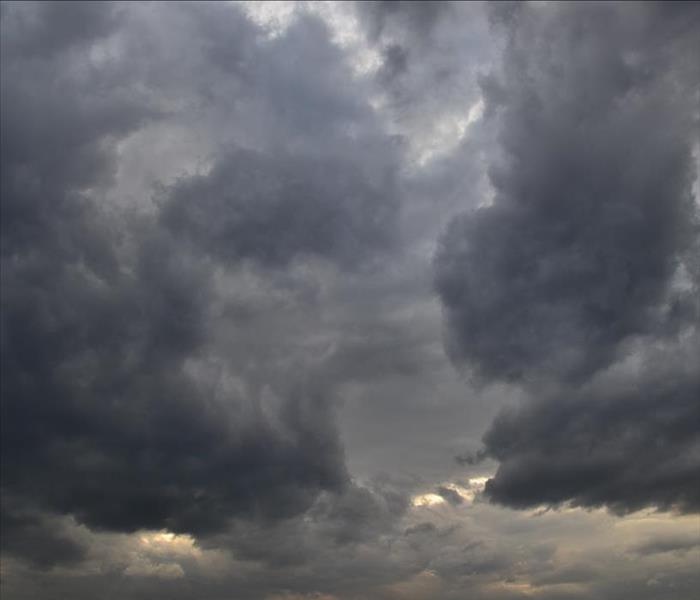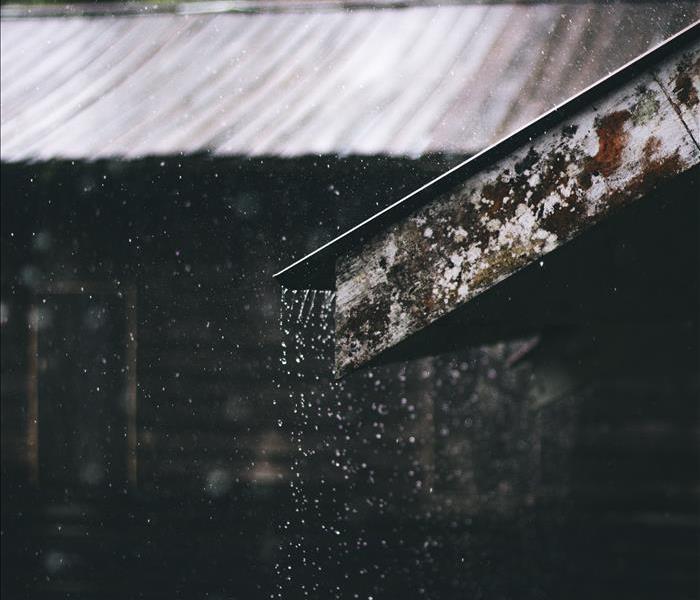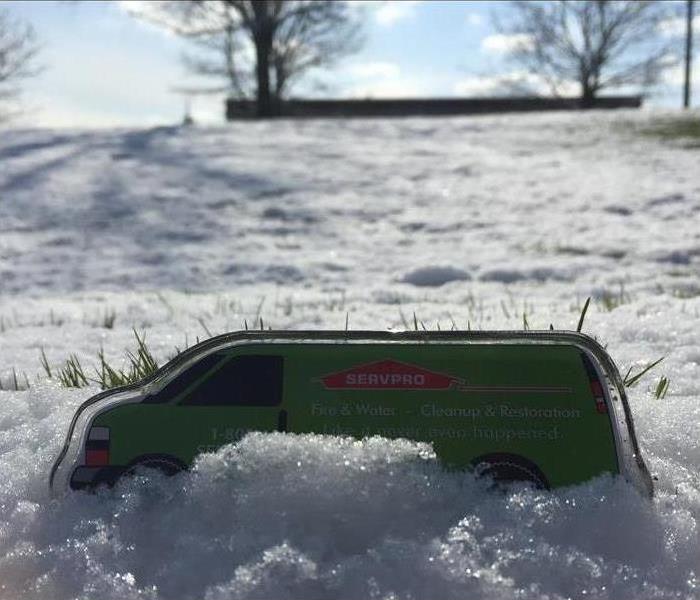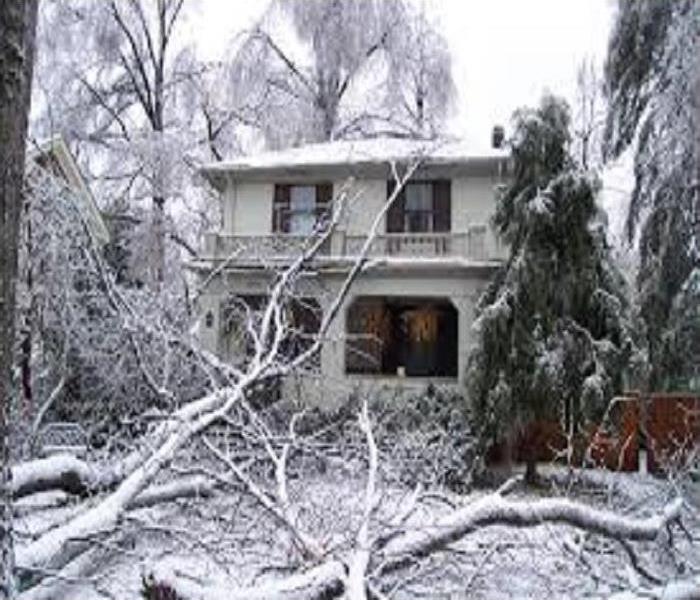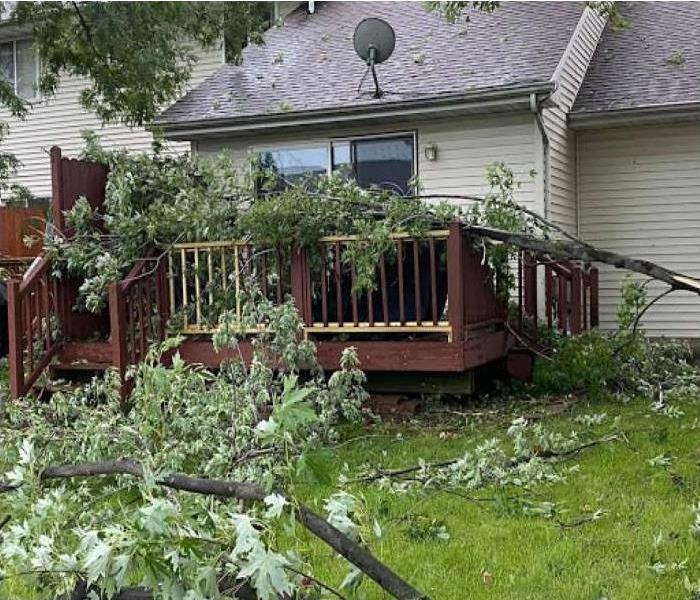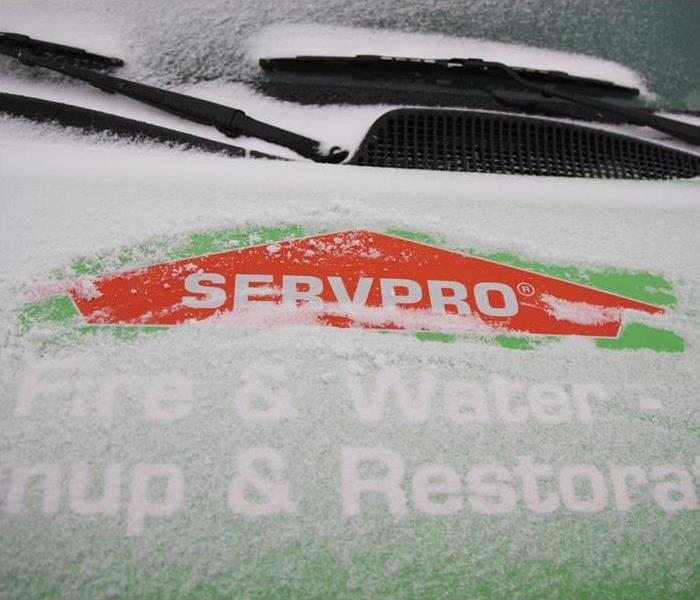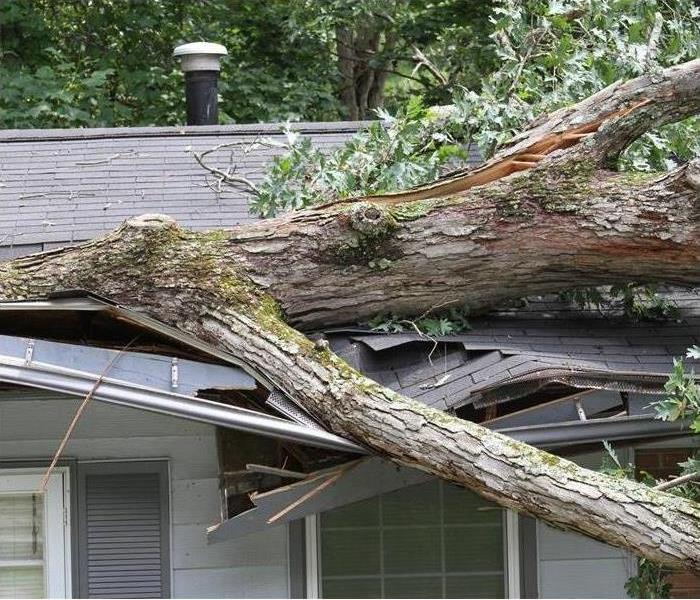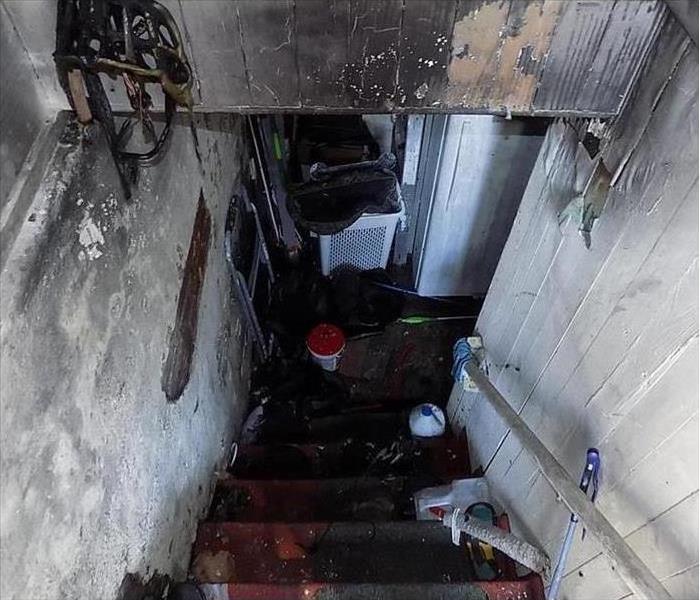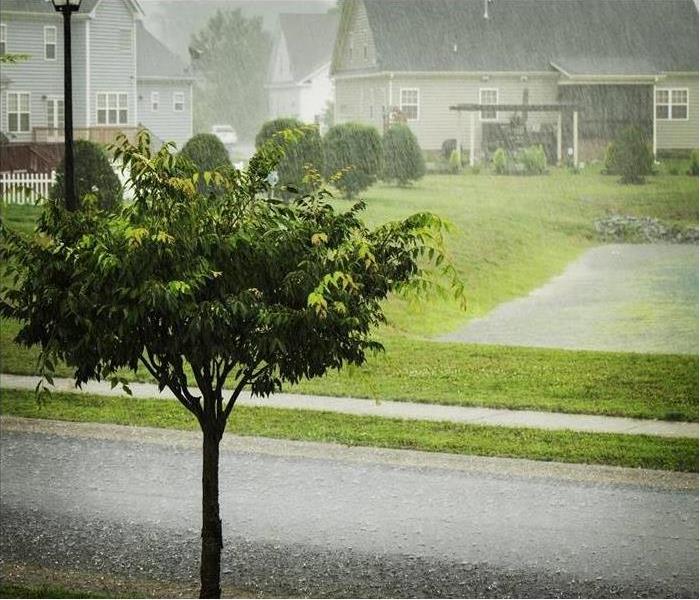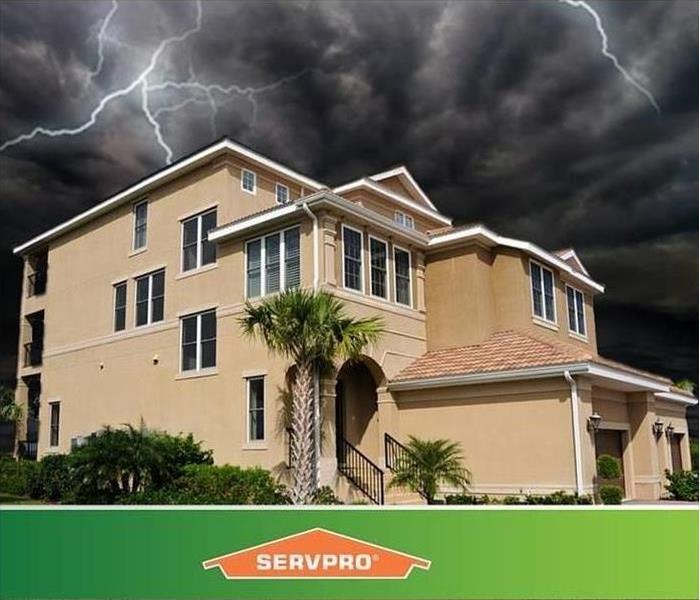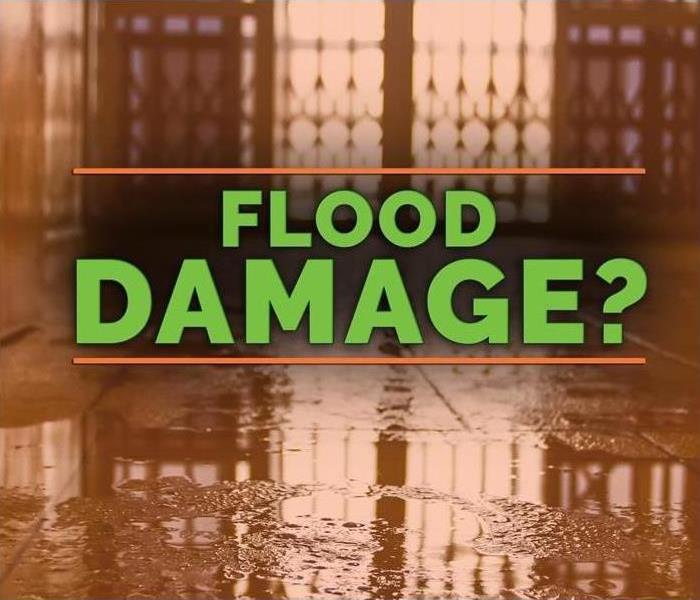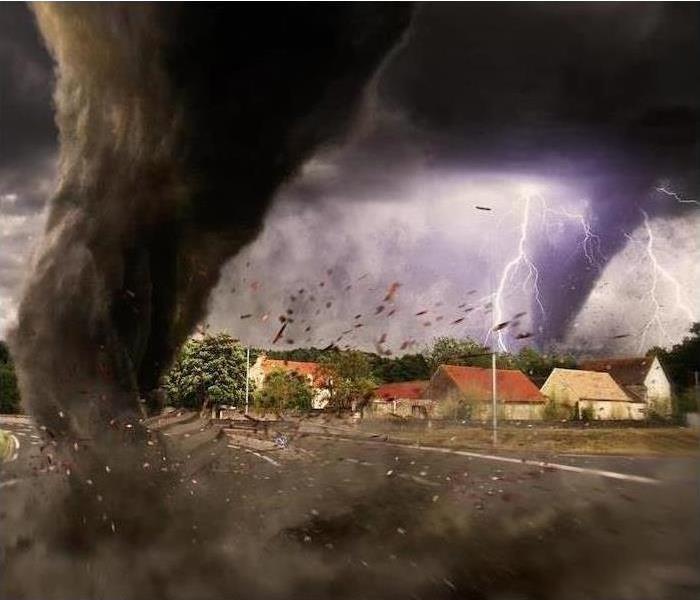Recent Storm Damage Posts
Navigating the Aftermath: Flood Damage Restoration in Champaign-Urbana
1/20/2025 (Permalink)
Champaign-Urbana, a vibrant hub of activity, faces the occasional threat of flooding. While summer showers often bring relief, heavy rainfall can quickly overwhelm the landscape, particularly with the ongoing urban development. Changes in the terrain can disrupt natural drainage, forcing water to seek new paths, often through unsuspecting homes.
The aftermath of a flood can be devastating. Mud-laden waters wreak havoc, leaving behind a trail of destruction that extends beyond the visible mess. SERVPRO® understands the urgency and complexity of flood restoration. Our team meticulously addresses the multifaceted challenges, prioritizing the safety and well-being of your family and property.
Our approach is comprehensive:
- Water Extraction & Structural Drying: We employ advanced techniques to remove excess water and expedite the drying process. This minimizes the risk of mold growth and structural damage.
- Content Restoration: Damaged belongings are carefully assessed and prioritized for restoration or disposal. We work diligently to salvage valuable items and minimize losses.
- Thorough Cleaning & Sanitization: Our expert cleaning protocols go beyond surface level. We employ antimicrobial agents to eliminate harmful bacteria and pathogens, safeguarding your family's health.
- Kitchen & Food Safety: We recognize the critical role of the kitchen in your family's well-being. Our specialized cleaning procedures ensure the elimination of flood-borne contaminants, restoring confidence in your food preparation area.
- Technology & Innovation: We leverage the latest technology in water extraction, drying, and cleaning to ensure efficient and effective restoration.
Call SERVPRO of Champaign/Urbana. We are always available to provide immediate assistance and guide you through the restoration process.
5 Ways Spring Disasters Can Damage Your Business In Illinois
3/25/2024 (Permalink)
As the seasons change and spring emerges, it's essential for businesses to be prepared for potential disasters that could impact their operations. From sudden storms to seasonal hazards, here are five ways spring disasters can damage your business:
1. Flooding: Spring brings melting snow and increased rainfall, leading to a higher risk of flooding. Floodwaters can damage inventory, equipment, and infrastructure, disrupting business operations and causing costly repairs.
2. Storm Damage: Severe spring storms, including thunderstorms, hail, and tornadoes, can cause significant damage to commercial properties. Strong winds can break windows, damage roofs, and topple structures, leading to business interruptions and safety concerns.
3. Water Damage: Spring rains and thawing snow can lead to water intrusion in buildings, causing water damage to walls, ceilings, and floors. Moisture buildup can also promote mold growth, posing health risks to employees and customers.
4. Power Outages: Spring storms can knock out power lines, resulting in extended power outages for businesses. Without electricity, businesses may experience disruptions to operations, loss of refrigerated inventory, and potential damage to electronic systems.
5. Landscape Hazards: Springtime landscaping hazards, such as fallen branches, overgrown vegetation, and unstable trees, can pose safety risks to businesses. These hazards can cause property damage, injury to employees or customers, and liability issues for business owners.
To mitigate the impact of spring disasters on your business, it's crucial to have a comprehensive disaster preparedness plan in place. This plan should include measures for preventing damage, responding to emergencies, and recovering quickly to minimize downtime. Additionally, partnering with a reputable restoration company like SERVPRO can provide peace of mind knowing that expert assistance is just a phone call away.
Stay proactive this spring and protect your business from potential disasters. By staying informed, prepared, and ready to take action, you can minimize the impact of springtime hazards and keep your business running smoothly.
How to keep your family safe when severe weather hits
1/11/2024 (Permalink)
We are getting into the thick of winter and with that comes snowy conditions and dangerously low temperatures. Here are a few tips to help keep you and your family safe and warm this season.
Being proactive before extreme weather hits your area
- Put together an emergency kit containing water, food, flashlights, and batteries that can sustain the household for at least 3 days
- Space heaters are a handy source to use throughout extreme weather. Please keep in mind the proper procedures when choosing and operating your space heater at home. A heater that has an automatic shut-off setting can help if you forget to turn it off or if the heater itself falls over. Additionally, keeping all mobile heating units at least 3 feet away from curtains, furniture, and blankets is a safe practice.
Different ways to ensure safety and prevent damage during extreme weather
- Make sure your home is well insulated and that you have weather stripping around your doors and window sills to keep the warm air inside.
- Ensure your carbon monoxide and fire detector have fresh and working batteries.
- Have a fire extinguisher easily accessible and ensure every household member knows how to use it. Harsh temperatures encourage the use of space heaters, house fires are easily started when the proper safety measures are not taken when operating mobile heating units.
- Keep a steady drip of warm and cold water from all faucets to keep pipes from freezing. Another helpful measure is to open the cabinets under the sink to allow heat access to the pipes.
- If a pipe bursts from freezing, make sure everyone in the household knows where the water main shut off is and how to turn it off.
- Insulate your home by installing storm windows or covering windows with plastic from the inside to keep cold air out.
- Keep a supply of dry firewood for any wood-burning stoves and/or fireplaces in the home.
- In the event that the power goes out, ensure you have the following:
- Extra blankets, sleeping bags, and warm winter coats
- Flashlights with fresh batteries or at the very least candles with holders per fire safety
- Make sure your cell phone has a full charge or that you have a mobile charger in the event the power goes out
The Process of Making a Flood Cut
1/17/2022 (Permalink)
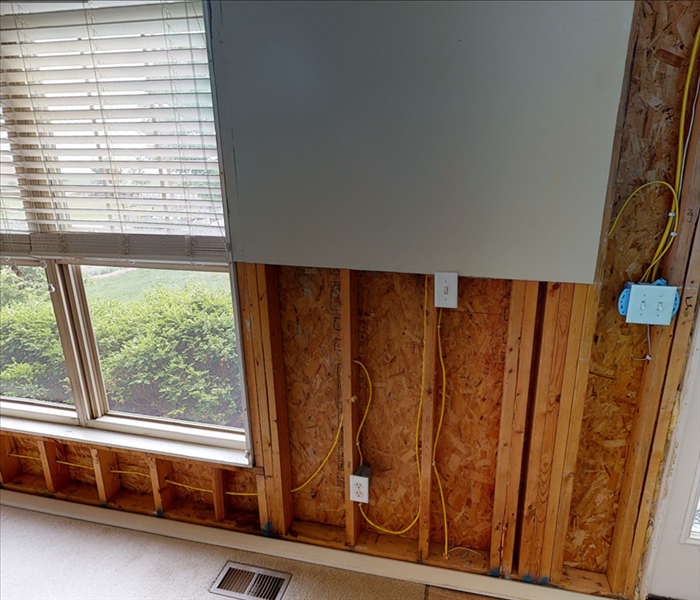 Example of flood cut
Example of flood cut
Flooding often leads to water damage, and water damage often leads to the removal of affected items and structures. If your home in Champaign/Urbana, floods during a storm, mitigation experts may have to use a flood cut to determine how much of your wall to tear out. A flood cut is a mark that is made 12-18 inches above the perceivable water damage to a wall to mark the point to which the technicians need to remove the drywall. Here are the steps of using a flood cut.
1. Determine Necessity
A flood cut is not always necessary. If water damage is minimal or the water is clean, the wall probably doesn't need to be removed. When the flooding is the result of a storm, however, the contamination of the water seeps into the walls. It's best, therefore, to mark them with a flood cut and remove the walls, especially if they are saturated.
2. Prepare for Mess
Removing the drywall is usually a pretty messy process. You will probably see the professionals put a tarp down before they begin. It's also advisable for them to wear gloves and protective clothing, especially if they will be removing damp insulation that's behind the wall.
3. Remove Wall
Once there is a tarp down to catch the falling drywall, the demolition process can begin. Technicians start at the flood cut and remove everything below it, ensuring that all the water damage is gone.
4. Clean the Mess
The wall that they tear out has to go somewhere. Another benefit of using the tarp is that it makes for easy cleanup. They can just gather the edges to contain the mess and head to the dumpster.
5. Replace Wall
Many mitigation professionals are also restoration experts. They can put new insulation and a new wall back up and blend the paint so that it looks "Like it never even happened."
If you have flooding in your home, you may need a flood cut to mark the spot where the wall gets removed. Understanding the steps of the process can help you know what's going on when the professionals arrive. If you experience water damage in your home, call us at (217) 355-0077.
Sump Pump Maintenance For Your Champaign/Urbana Home
1/4/2022 (Permalink)
A sump pump is one of the most important parts of basement plumbing equipment. It makes sure that any accumulated water in your home and around its foundation is promptly pumped out and away from your home to a storm sewer or containment pond, so it doesn't allow your basement to flood, damaging your possessions. At least, that's what it is supposed to do. If your sump pump is not regularly and properly tested, then you can't guarantee that it will come through when you need it most.
- Inspect the pump and its outlet pipe
Start the inspection by listening. If there is excessive groundwater around the foundation, the pump should turn itself on, pumping out the water and turning itself off again. Next, remove the cover and look inside the sump pit. If the level of water is low, there is a high chance the pump is working properly. Examine the sump pump for any signs of external damage, as well as any obstructions or debris in the surrounding pit. You will also want to see if the outlet pipe that carries water from the pump to outside your home is free of any blockage. And the check valve is working properly.
- Check the electrical components
Your sump pump should be plugged into a Ground Fault Circuit Interrupter, which protects it from a potential short while it is submerged. Consider getting yourself a battery-based backup pump for your sump pump that will kick on if your primary sump pump fails.
- Test the sump pump
Test your sump pump by pouring in five gallons of water. The pump should then turn on once the water level reaches a predetermined level below the basement floor. If the pump doesn’t turn on, it could be either clogged or damaged, and you should call a licensed plumber for help.
- Clean and maintain your sump pump
The typical lifespan of a sump pump is 10 years but if your sump pump is running often, you should consider replacing it every 5 to 7 years. Inspect and test your sump pump at least once a year. To be safe, check your sump pump before a big storm hits your area.
If you experience a loss due to your sump pump failing, don't hesitate to call the professionals at SERVPRO of Champaign/Urbana at (217)355-0077.
Storm Safety Tips in Champaign/Urbana
12/13/2021 (Permalink)
We often see cumulonimbus clouds in the sky in Champaign/Urbana as we gaze east. These clouds can produce thunderstorms. Although thunderstorms are typically about fifteen miles in diameter and last about thirty minutes, they can be dangerous.
SERVPRO of Champaign/Urbana responds to storm damage emergencies throughout the year and has seen the damage strong winds can cause to structures. Here are some thunderstorm facts from the National Oceanic and Atmospheric Administration (NOAA):
Severe Thunderstorms
- Severe thunderstorms produce large hail or winds of at least 58 miles per hour
- Some wind gusts can exceed 100 miles per hour and produce tornado-like damage
- When a severe thunderstorm threatens, stay inside a strong structure
- Mobile home occupants should go to a more permanent structure
Lightning
- All thunderstorms produce lightning
- Get inside a building or enclosed vehicle
- If caught in an open area with lightning around, crouch down immediately! Out your hands on your knees, but do not lie down on the ground.
- Do not use a telephone or electrical appliance. A nearby lightning strike can travel through the phone or power lines right into the home.
- Avoid seeking shelter beneath lone trees
Call Us Today!
When you have a storm damage emergency, SERVPRO of Champaign/Urbana is on-call and ready to respond 24-hours a day. Call us today at (217)-355-0077.
Flood Odor and the Removal Process
11/29/2021 (Permalink)
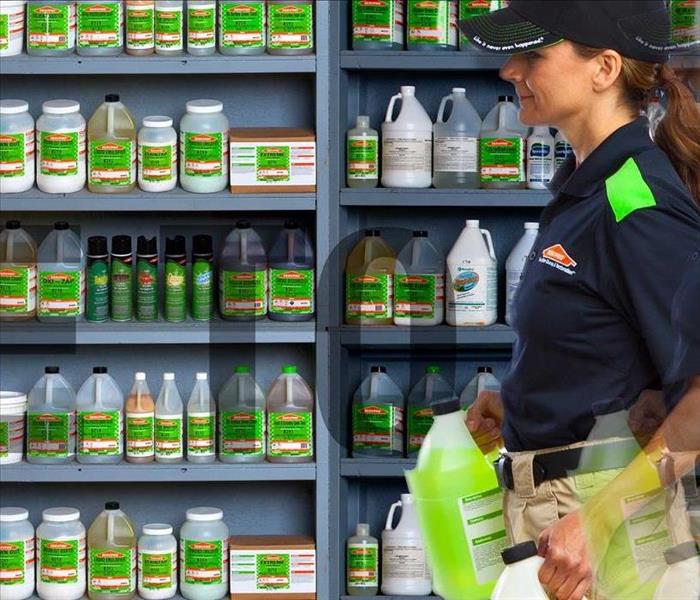
Flood water is typically a mixture of overflowing rivers and sewage loss. It is no surprise, then, that floods leave behind a significant odor when they recede, especially when you consider the addition of mold growth. For most homeowners, the elimination of the smell is the most substantial part of the removal process; however, it can be overwhelming to figure out just what to do. The following four steps should help ease your mind.
1. Wet Vac and Dry Flooded Areas
The first step to removing the odor in your home is the same as the first step for restoration: remove any excess water and dry flooded areas thoroughly. To speed up this process, you’ll want to have on hand several wet-vacs, industrial fans, and air movers. In addition to these tools, you should open up all doors and windows to help ventilate your home.
2. Remove Affected Materials
Beyond removing excess water and drying out damaged areas, you’ll want to remove all affected materials, including carpeting, draperies, drywall, and insulation. Any of these items that are left and may contain moisture can lead to further mold growth, which will contribute to both the odor and other health effects.
3. Steam Clean and Disinfect Everything
Once your home is thoroughly dry and affected materials have been removed, it is time to clean and disinfect everything. You will want to rent steam cleaners and purchase several mops and rags. You can begin by mopping all the floors and wiping down all walls with your choice of disinfectant. You can follow this by steam cleaning any remaining carpeting, draperies, or furniture. After you have done all the scrubbing, you should also disinfect any plumbing fixtures and ductwork.
4. Call an Expert
There is no reason to have to go it alone.
The odor that occurs after flooding is a combination of sewage and mold growth. While it may seem unbearable and resilient, the steps above should help you remove the odor and restore your home to some degree. If you are unable to get rid of the odor yourself, call the professionals at SERVPRO of Champaign/Urbana at (217)-355-0077
10 Things You Should do to Keep Rain Water Out of Your Champaign/Urbana Home
9/23/2021 (Permalink)
Here are 10 things you should do to keep rain water out of your Champaign/Urbana home.
- Increase Grade: The ground around your home should be sloped away from your property to divert water. It's a very simple process, borrow dirt from three feet away from the structure, and toss it against the side of the structure creating a slope.
- Clean Rain Gutters: You should clean your gutters annually. A clogged gutter can send rain water running down the exterior wall, which can result in water entering interior walls.
- Divert Down Spouts: At the local hardware store you can purchase a black plastic corrugated hose that fits around the base of the downspout. This hose carries water away from the structure, preventing water from seeping into the foundation.
- Roof Maintenance: You should have your roof inspected every 5 years. Your roof is the first line of defense, with one tear in a rubber membrane or crack in a tin roof, or a compromise in the plywood structure of the roof can be disastrous for the interior of your structure.
- Window Repairs: Proper window installation and maintenance is very important. Modern windows are fitted with well and drains to help guide water outside of the house. Improper caulking can be disastrous by sending water into the structure instead of draining it away.
- Sweep Away Debris: During spring and fall especially, you should sweep outdoor surfaces weekly. Sweep patios and door well to prevent debris from clogging exterior drains.
- Expand Exterior Drains: By expanding the surface area of exterior drains decreases the likelihood of clogging the drain.
- Construct a Swale Ditch: Constructing a ditch and filling it with landscaping rock can help divert water away from the structure, especially for yards that are extremely flat.
- Exterior French Drain: For structures on a slope, an exterior French drain, including a subterranean ditch with a black perforated corrugated hose, can be used to divert surface water away from the structure.
- Install a Sump Pump: When all else fails, installing a sump pump may be the solution. You will need to dig a well through the basement or slab of structure. The well may be up to 7 or 10 feet deep. As the water table increases, a sump pump activates and transports water away from the structure.
If you have water damage concerns due to rain water please feel free to give SERVPRO of Champaign/Urbana a call, we're always here to help (217) 355-0077.
What Makes Storm-Related Flash Floods So Dangerous
8/24/2021 (Permalink)
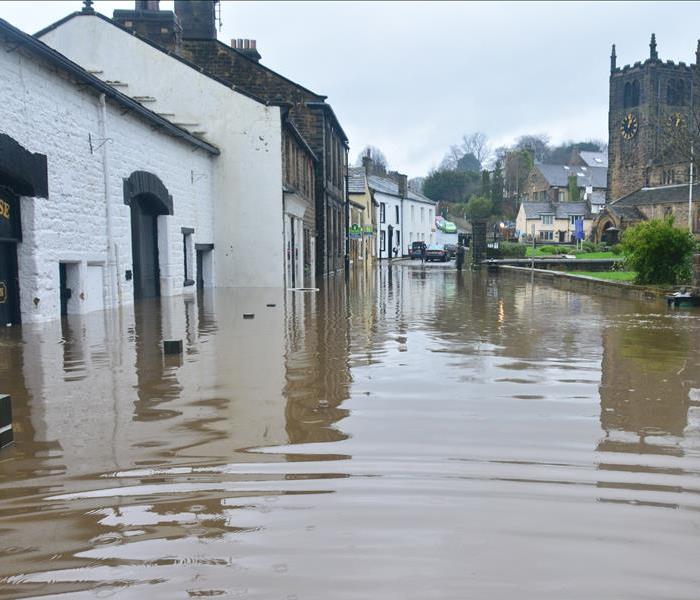 Flood waters can rise quickly and unexpectedly.
Flood waters can rise quickly and unexpectedly.
Severe weather can be dangerous in many different ways—between lightning strikes, high wind and hail, there are countless ways that storms can cause damage. However, many people are surprised to learn that floods are the most dangerous severe weather incident of all. Floods are second only to heat when it comes to weather-related fatalities in the United States, and flash floods present the biggest risk.
Any type of flooding can be quite dangerous, but when it comes to flash floods, their sudden onset in addition to their ability to impact any area creates a deadly combination. Additionally, because any body of water can overflow during heavy rains, flash floods can impact any area—that is why we encourage people to always be aware of their risks and the top safety tips.
What Makes a Flood a Flash Flood?
A traditional flood will slowly begin to rise, while a flash flood must occur within the first six hours after a storm, but they often happen in as few as three hours. Flash floods tend to be more common in urban areas due to the possibility of blocked storm drains and drainage systems, and they can occur even in areas that are not situated low enough to be a regular flood concern.
What Are the Flash Flood Alert Guidelines?
Because flash floods can come about with little notice, if there is a storm and heavy rain in your area, you should always stay alert to local weather alerts so you have as much notice as possible in case waters near you start to rise.
Officials will issue a flash flood watch for a general area to encourage heightened concern, but if things progress to a warning, you will want to quickly take the proper precautions. If a flash flood emergency is issued, move to higher ground as quickly as you can, as these are rare and deadly conditions.
What Can I Do to Reduce My Flash Flood Risk Level?
It is important to prioritize safety for any severe weather event, but flash floods should be especially revered. Knowing the rules for safety can keep you and your family much safer if the waters suddenly begin to rise:
- If rain is heavy for an extended period, tune into official weather warning channels.
- Make sure you have a clear safety plan in place and that your family knows how to execute it.
- If you come across floodwater, never attempt to cross it by car or on foot.
- Avoid coming into contact with floodwater, as it can hide electrical currents and contaminants.
- When evacuating, have alternate routes in mind in case yours is blocked by water.
If your Champaign/Urbana home or business has been damaged due to a flood or other severe weather, you can depend on us. Call us at 217-355-0077.
Winter Storm Prep Before It’s Too Late
1/18/2021 (Permalink)
It's that time of the year again, time to prepare ourselves and homes for the brutal cold of winter storms. It is not something anyone looks forward to but it is best to be prepared.
Before Snowstorms and Extreme Cold
- Make a family communication plan. Your family may not be together when disaster strikes, so it is important to know how you will contact one another, how you will get back together and what you will do in case of an emergency.
- Make an emergency kit for at least three days of self-sufficiency.
- Keep space heater safety in mind: Use electric space heaters with automatic shut-off switches and non-glowing elements. Remember to keep all heat sources at least three feet away from furniture and drapes.
Prepare You Home
- Make sure your home is well insulated and that you have weather stripping around your doors and window sills to keep the warm air inside.
- Make sure you have a working carbon monoxide detector.
- Keep fire extinguishers on hand, and make sure everyone in your house knows how to use them. House fires pose an additional risk, as more people turn to alternate heating sources without taking the necessary safety precautions.
- Learn how to shut off water valves (in case a pipe bursts).
- Insulate your home by installing storm windows or covering windows with plastic from the inside to keep cold air out.
- If you have a wood burning fireplace, consider storing wood to keep you warm if winter weather knocks out your heat. Also, make sure you have your chimney cleaned and inspected every year.
- Have at least one of the following heat sources in case the power goes out:
- Extra blankets, sleeping bags and warm winter coats
- Fireplace or wood-burning stove with plenty of dry firewood, or a gas log fireplace
- Make sure you have a cell phone with an emergency charging option (car, solar, hand crank, etc.) in case of a power failure.
- Plan to bring pets inside.
- Know where the manual release lever of your electric garage door opener is located and how to operate it in case you lose power.
What to do during a power outage
1/5/2021 (Permalink)
 Power Outage
Power Outage
When unexpected weather strikes and causes it is important for everyone to be prepared for a power outage that may last for several hours or days after a heavy storm.
Before a Power Outage:
- Build or restock your emergency preparedness kit, including a flashlight, batteries, casa, and first aid supplies.
- Make sure you have alternative charging methods for your phone or any device that requires power.
- Charge cell phones and any battery-powered devices.
- Know where the manual release lever of your electric garage door is located and know how to operate it.
- Learn about the emergency plans that have been established in your community.
During a Power Outage:
- Avoid using candles which can cause fires. Only use a flashlight for emergency lighting.
- Keep refrigerator and freezer doors closed. Most food requiring refrigeration can be kept safely in a closed refrigerator for about four hours. A full freezer will keep the temperature for about 48 hours.
- Put on layers of warm clothing if it is cold outside. Never burn charcoal for heating or cooking indoors.
- Only use generators away from your home, and NEVER run a generator inside a home or garage, or connect it to your home’s electrical system. Consult an electrician or engineer before purchasing and installing a generator.
After a Power Outage:
- Throw away any food that has been exposed to temperatures of 40*F (4*C) for two hours or more. When in doubt, throw it out.
- If food in the freezer is colder than 40*F and has ice crystals on it, you can refreeze it.
- Contact your doctor if you’re concerned about medication having spoiled.
- Store at least a three-day supply of non-perishable food.
- Avoid foods that will make you thirsty.
Winter Storm Damage What To Do
12/14/2020 (Permalink)
Even if the blizzard was so destructive that damage occurred to your home regardless of all the preventive measures you had taken, there is no room for panic. Just keep your wits about you and make no hasty decisions. SERVPRO of Champaign/Urbana is here to help get your life back like it never even happened.
First, ensure the safety of all family members; make sure no one enters a damaged area in a desperate attempt to rescue any of your household items. No property loss is comparable to having a loved one injured. Find shelter where everyone will be safe and warm, like an intact room in your home or a neighbor’s, friend’s or relative’s place if the damage was extensive or some danger (such as fire hazard) lurks in your residence.
Contact your insurance agent immediately after the storm is over. Have a representative of the company come over for estimates at the earliest opportunity and ask for required documents. Provide all the relevant information and gather convincing evidence of the ruins caused by the winter storm.
Take photos and videos of any water damage inside your home or wind damage on the outside, before you have touched anything. Rescue your provisions from the basement or your belongings from a flooded room before they are completely ruined. Then, make the necessary repairs to prevent further damage by draining water, covering broken windows, block leakages, etc.
If the damage to your home is substantial, contact SERVPRO of Champaign / Urbana at 217-355-0077 we are here to help in your time of need to get you back in your home and life faster.
Winter Storm Damage
11/30/2020 (Permalink)
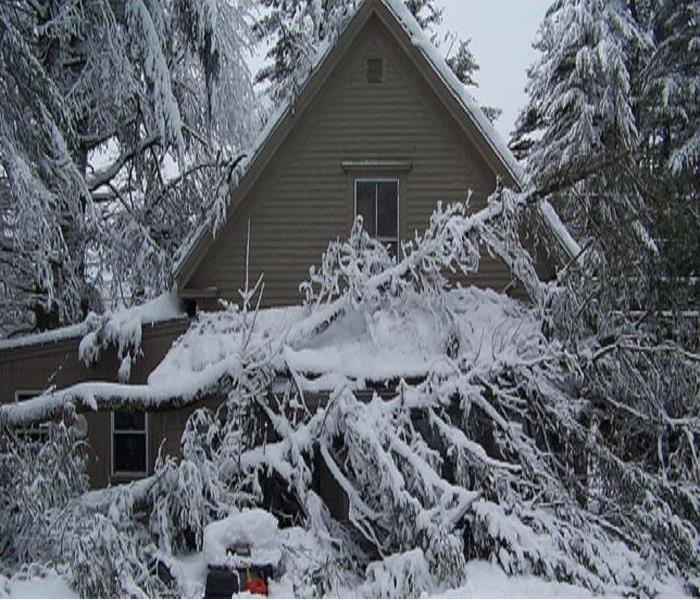 Winter Storm
Winter Storm
Cold weather poses a distinct challenge to property owners. Ice, snow, and sleet can play havoc with your roof, siding, driveways, and walkways. Illinois’s frequent freeze and thaw cycles can lead to frozen pipes, leaks, and other property emergencies. We even have to deal with the occasional unseasonal warm up, followed by thunderstorms and tornado warnings. Winter storm damage is nothing to laugh about — and quick action to deal with the damage is essential to protecting your investment in your property.
Common Types of Winter Storm Damage You Might Face
It’s easy to imagine getting snowed in or having to deal with slippery surfaces due to ice, but there are actually many potential emergencies caused by winter storms. It’s a good idea to know some common disasters you might be up against before a storm arrives.
- Flooding— Cold snaps and freezes can damage pipes and cause them to burst, leading to water damage and flooded areas that need emergency restoration.
- Fires— Whether it’s due to unattended fireplaces, improperly cleaned chimneys, or space heaters plugged into overloaded outlets or left too near flammable objects, fires can often happen during a winter storm.
- Roof leaks— Frozen ice that melts, ice dams that block drainage pipes, heavy snow and ice breaking through shingles, hail strikes, and even high winds from winter storms can all be harsh on your roof, leaving your property exposed to moisture damage.
SERVPRO of Champaign / Urbana has helped hundreds of commercial business owners and property managers deal with disasters related to winter storms. Years of storm restoration projects — even on our very own property — have taught us that when property owners plan ahead and know what to do fast, it lessens the effects of the disaster. Call SERVPRO of Champaign / Urbana at 217-355-0077 let us make your disaster "Like it never even happened."
STORM DAMAGE RESTORATION IN THE MIDWEST
10/12/2020 (Permalink)
Living in Illinois, you know this summer we've experienced severe storms, seemingly one right after another. Severe storms may become dangerous and it is crucial to know the different types of storm damage and how they can impact your home. Leaving your home left untreated after damage from pounding rain, hail, lightning, tornado, high winds, or heavy snow can lead to water damage, mold, and structural damage. A rapid response by SERVPRO of Champaign/Urbana is critical to reducing the safety risk and secondary damage from weather.
There are three ways storms can damage your home. Lightning storms can occur at any time. These storms bring the threat of fire and structural damage. During a lightning storm, even if your home is properly equipped to handle lightning, it is still possible to have damage to electrical wiring, appliances, antennas, satellite dishes, cable or telephone lines, and steel framework and more. Always stay indoors during the storm unless there are signs of a fire. Flooding presents a serious risk to your home and to your safety. When it comes to structures, flooding can lead to dangerous contamination and water damage to drywall, support beams, and foundations. There is a risk for mold within the first 24 hours of a flood so it is vital to extract water and have a professional begin mitigating immediately. Finally, high winds can occur virtually anywhere. Thousands of storms and hurricanes hit the U.S. every year. Severe winds are defined as exceeding 50-60 mph and include downdrafts, downbursts, tornadoes. Damage from the wind can be widespread and affect not only your structure, but surrounding landscaping and asphalt. Be aware of the potential for falling trees, poles and damaged power lines. A storm may damage your home including windows, siding, and roofs. In the most extreme scenarios, roofs can be blown completely off. In the case of a tornado, a warning should be given on TV or radio. The safest place to be during a tornado is in a basement. If there is no basement available, seek shelter in an interior room without windows since windows may shatter and spray glass. Remain under shelter with a radio until you receive notice that the tornado has left the area. With floods, there is usually some indication if one is imminent, especially if you live in an area susceptible to flooding. Make sure to have copies of important documents that could be destroyed in a flood, such as birth certificates, social security cards, and deeds. Finally, thunderstorms generally don't cause much damage except for being loud, but when they do they can be hazardous. To avoid potential damage, make sure to trim any large limbs near your house. Secure any outdoor objects to keep them from blowing away. Unplug electronic devices prior to a storm to prevent a surge from destroying them. Should a storm damage your home SERVPRO of Champaign/Urbana is here to help! Call one of our friendly staff today at 217-355-0077.
STORM DAMAGE RESTORATION IN THE MIDWEST
9/9/2020 (Permalink)
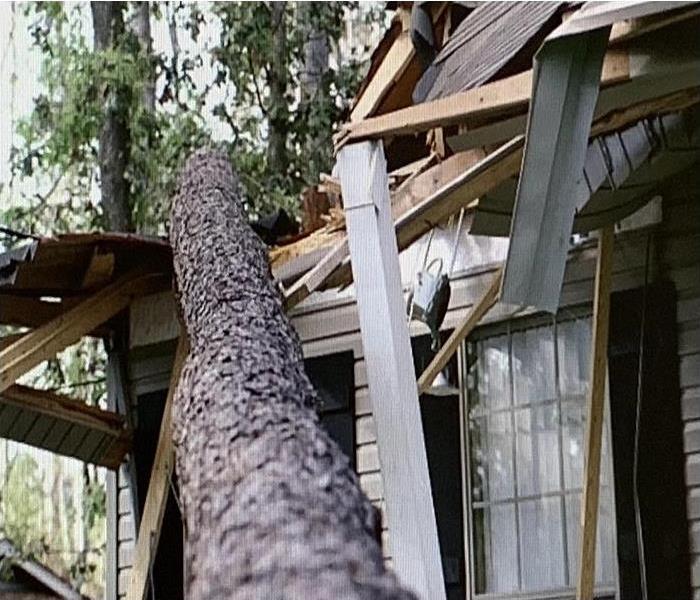 Storm Damage Restoration
Storm Damage Restoration
Living in Illinois, you know this summer we've experienced severe storms, seemingly one right after another. Severe storms may become dangerous and it is crucial to know the different types of storm damage and how they can impact your home. Leaving your home is left untreated, damage from pounding rain, hail, lightning, tornado, high winds, or heavy snow can lead to water damage, mold, and structural damage. A rapid response by SERVPRO of Champaign/Urbana is critical to reducing the safety risk and secondary damage from weather.
There are three ways storms can damage your home. Lightning storms can occur at any time. These storms bring the threat of fire and structural damage. During a lightning storm, even if your home is properly equipped to handle lightning, it is still possible to have damage to electrical wiring, appliances, antennas, satellite dishes, cable or telephone lines, and steel framework and more. Always stay indoors during the storm unless there are signs of a fire. Flooding presents a serious risk to your home and to your safety. When it comes to structures, flooding can lead to dangerous contamination and water damage to drywall, support beams, and foundations. There is a risk for mold within the first 24 hours of a flood so it is vital to extract water and have a professional begin mitigating immediately. Finally, high winds can occur virtually anywhere. Thousands of storms and hurricanes hit the U.S. every year. Severe winds are defined as exceeding 50-60 mph and include downdrafts, down-bursts, tornadoes. Damage from the wind can be widespread and affect not only your structure, but surrounding landscaping and asphalt. Be aware of the potential for falling trees, poles and damaged power lines. A storm may damage your home including windows, siding, and roofs. In the most extreme scenarios, roofs can be blown completely off. In the case of a tornado, a warning should be given on TV or radio. The safest place to be during a tornado is in a basement. If there is no basement available, seek shelter in an interior room without windows since windows may shatter and spray glass. Remain under shelter with a radio until you receive notice that the tornado has left the area. With floods, there is usually some indication if one is imminent, especially if you live in an area susceptible to flooding. Make sure to have copies of important documents that could be destroyed in a flood, such as birth certificates, social security cards, and deeds. Finally, thunderstorms generally don't cause much damage except for being loud, but when they do they can be hazardous. To avoid potential damage, make sure to trim any large limbs near your house. Secure any outdoor objects to keep them from blowing away. Unplug electronic devices prior to a storm to prevent a surge from destroying them. Should a storm damage your home SERVPRO of Champaign/Urbana is here to help! Call one of our friendly staff today at 217-355-0077.
Emergency Evacuation Kits
6/10/2020 (Permalink)
An emergency evacuation kit should contain the documents and personal items needed to maintain yourself and your family for up to a week in the event of an emergency evacuation. Your kit may look very different from your neighbor’s kit, depending on the number of children, pets, and advance preparation for such events. The following are suggestions of what you may need in your emergency evacuation kit.
Emergency Evacuation Kit Basics
The American Red Cross, Centers for Disease Control and Prevention, and FEMA all recommend that water, food, a flashlight, appropriate batteries for your accessories, a first-aid kit, and a battery or hand-operated radio be included in your evacuation kit. Regardless of the size or needs of your family, here is a list of additional items that should be included in every evacuation kit.
Along with bottled water, pack a small filtration system for an unlimited water supply
Pack solar device chargers and solar lights (similar to those used in landscaping)
Flashlights are good but LED headlamps free up your hands
Emergency whistles (one for each family member)
7 days of nonperishable food (don’t forget the can opener)
7 days or more worth of under garments and socks
Multiple days worth of prescription medication
Surgical or dust masks
Maps of your area and of your destination
Cash or traveler’s checks (without power, ATM machines are rendered useless)
A tool kit that includes a sharp knife, pliers, tweezers, electrical, and duct tape
An extra set of house, car, and safe keys
Charged two-way radios (walkie-talkies)
Add extra bandages, gauze, sanitizing washes and burn cream to your first-aid kit
Note: For items like clothing, food, cash, batteries, etc., use watertight resealable bags to keep them dry until needed. Part of your evacuation plan should include how you intend to reach out-of-town family members and/or friends.
Evacuation Kit Items for Infants and Children
During an evacuation, special attention should be given to the needs of your children. Older children in their teens may want to prepare an evacuation kit of their own. Consider the following:
Infant formula, diapers, wipes, pacifier, extra bottles
Water (1gallon per day, per child)
Nonperishable food and snacks like energy bars, jerky, and trail mixes
Multiple changes of clothing
Mylar blankets (regular blankets and sleeping bags can get bulky and overwhelming)
Extra glasses, medication, inhalers, and other medical or individual necessities
Evacuations can be extremely stressful for children. Take the time to practice or run an evacuation drill. The more your children are familiar with what they need to do, the less difficulty you will have getting them to do it.
Evacuation Kit Important Documents
The following list of documents will help you to prove your identity, as well as give you access to insurance benefits, medication, finances, and much more:
Notarized copies of everyone’s birth certificates
Copies of passports, identification cards and driver’s licenses
Copies of health insurance cards, current prescriptions, and medical needs
Copies of credit cards and your ATM card
A hard copy of your online usernames and passwords
Copies of your auto and homeowners insurance cards and or policies**
Copies of recent utility bills (to turn service on or off)
Copies of the deed or lease to your home
Notarized copies of wills
Family and emergency contact information (telephone numbers and addresses)
Copies of pet identification and proof of vaccination
Current pictures of your self, your spouse, children and pets in case of separation
The importance of the above-listed documents cannot be overstated. During major evacuation events, you may be away from your home for several days or weeks. The ability to use and manage your resources will help you get back to your home and back to normal quickly.Keep all of your documents, cards, and copies protected in airtight and watertight envelopes, bags, and/or containers. Upload your copies to a cloud service or save them on a memory stick along with safeguarding hard copies in your evacuation kit. Keep in mind that the cloud or a memory stick will do little good during wide-spread power outages.
Evacuation Kit Items for Pets
Your pets are essential to the well-being and happiness of your family. The following items should be included in your (or their very own) evacuation kit:
Enough food for 7 days (don’t forget the bowl)
1/2 to 1 gallon of water per day
Collar, leash or carrier
ID tags
Proof of vaccinations and any medical needs
Grooming accessories
Blanket or bed
Note: Pets can feel stress and inherently catch on to your change in mood and/or way of being. When running an evacuation drill, make sure your pets and their evacuation kits are a part of it.
Evacuation Kit Items for The Elderly
In the case of the elderly, the following items should be a part of your evacuation kit or ready to take at a moment’s notice:
Water (1gallon per day) for drinking and hygiene
Special hygiene necessities (adult diapers, denture containers, etc)
Food for a minimum of 7 days (attend to special requirements or needed supplements)
Medications and copies of prescriptions (especially life-preserving ones)
Canes, walkers, wheelchair, and other devices for support and mobility
Books, cards, or activities to occupy time
Identification or medical bracelets or necklaces
Everyone has a different take on what they prioritize when making disaster plans or assembling evacuation kits. Except for newborns and infants, everyone should be allowed to express what they feel is necessary for their comfort during an emergency evacuation.
Emergency Evacuation Kit Maintenance
It is crucial to periodically check prescription medication expiration dates, use by dates on canned goods, battery charge, and the proper functioning of all electronic items. This is the time to update your action plan and remove or add items your family has either outgrown or has come to require. This maintenance should be done bi-annually and can accompany your family’s evacuation drill. If your region is prone to flooding, there are steps you can add to your action plan in the event your home is flooded.
By preparing and keeping up with your emergency evacuation kit, you are positioning yourself to successfully navigate the disruptions of a natural disaster or mandatory evacuation. Without an evacuation kit, you could be left scrambling to assemble vital information, documents, and necessities when you should be moving yourself and your loved ones away from danger.
Mother Nature Hits Again
5/5/2020 (Permalink)
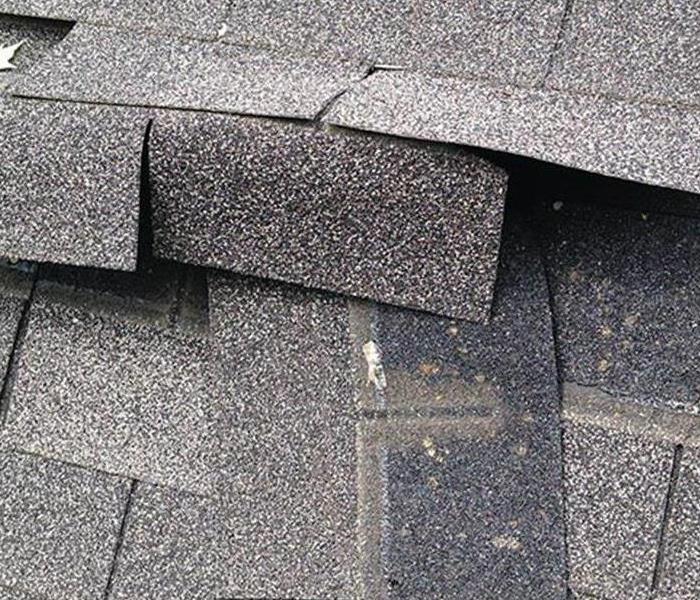 Shingle Damage Due to a Storm
Shingle Damage Due to a Storm
When Mother Nature hits, it can hit hard, and your home is often in the path of destruction. Storm damage can cause expensive long-term problems when repairs aren’t carried out quickly. High winds, heavy rain, flooding, and even lightning can all cause damage to your home. From water running down roof beams into the walls to debris damaging windows, there are many ways a storm or tornado can damage your property. The sooner the damage is assessed, the quicker you can see the need for repairs – and start the insurance claim process.
Ten Steps to Check Your Home for Storm Damage
1. Check for Debris on the Roof
Tree branches and other debris can cause large problems to a home particularly the roof. A damaged roof can cause big problems, even if the impact site is only small. Water may leak in during the storm and may be unseen for some time until it pools and becomes a big problem. Clear any debris you can, if you can access it safely, and inspect the roof shingles for damage.
2. Look for Missing or Broken Roof Shingles
Scan the roof thoroughly. Are any shingles missing or slipped from the storm? A shingle that’s still on the roof but has slipped can still be a cause of water damage. Cracked shingles, if you can see them, are also a sign of weather damage to your home. This could indicate a larger impact from debris, too, which may have affected other parts of the roof.
3. Inspect Your Chimney Flashing and Gutters
The metal flashing around your chimney can come loose or been damaged during the storm. This could mean that there is the potential for water damage inside your home. Water runs underneath the flashing, down the chimney or roof beams, causing dampness. Gutters may also come loose or blocked during the storm. A blocked or loose gutter is a sign that your roof may not drain properly. Water pools on the roof can weaken the structure and cause water damage.
4. Assess Water Stains on Interior and Exterior Walls
Can you see any clear damp patches either outside or inside your home? Hard and heavy rains can cause water damage as water runs into small cracks in the walls. Exterior walls can take a few days to dry out, so by checking over a three day period will help you catch these cracks.
5. Check Exterior Walls for Holes
A classic sign of storm damage is a spider-web pattern of cracks that radiate out from a central point. This indicates an impact has occurred on the outside wall. Smaller signs of damage include chipped paint or plaster or minor holes in a stucco exterior.
6. Check Your Windows
Your windows may not be clearly broken by the storm, but give them a second look. Small cracks, glass panes that are loose, or even damaged window frames can all lead to much larger problems. Look for signs of water inside your windows, as this indicates a small leak that could be a big problem. Check also for damage caused by flying debris or high winds to your window frames. Dented or cracked frames can cause your window to become loose and a hazard.
7. Scan Your Soffits
When you get an opportunity where you can safely access your soffits, look closely at the surface. Any dents, cracks and paint chips caused by hail or debris may be a sign of a bigger problem underneath. If you see a dent or crack in your wooden or PVC soffits, inspect the area in more detail. Is the soffit loose? Has water been drawn into any areas it shouldn’t? Make a note of the dents and paint chips you can see: the more there are, the greater the chance of costly underlying damage.
8. Investigate Your Outbuildings and Fencing
When you’re checking your property after a storm, don’t forget any outbuildings or fences. Walk around your outbuildings and check for signs of water damage. Check windows and frames and make sure doors haven’t been damaged by high winds. Take a walk around your perimeter fencing. Make a note of any damaged or missing panels, or of damaged posts that will need to be replaced to secure your boundary once again.
9. Assess Trees and Pylons on Your Property
Check any pylons on or adjacent to your property for signs of damage caused by high winds. Slack or broken cables, or tilting pylons, are all cause for concern. Call the utility supplier as soon as you notice any problems, do NOT attempt to approach downed power lines. This can cause serious injury or even death. You should also check out the trees on your property for loose branches that pose immediate danger to vehicles or your home.
SERVPRO of Champaignn/Urbana is here to help! We can help with everything from tarping a roof to water clean up and much more. If you think your home has suffered at the hands of nature, give SERVPRO of Champaign/Urbana a call at 217-355-0077. Our friendly and caring staff are here to help get you and your family back to normal.
4 Tips for Making a Flood Insurance Claim
1/27/2020 (Permalink)
4 Tips for Making a Flood Insurance Claim
If your home has been damaged in a flood, then you will need to make a flood claim to help cover the costs of repairs. Addressing the situation in the right way will help you get through the process more easily and with less stress. The following tips may help.
- Call Right Away
When making a flood claim, it is important to contact your insurance company as soon as you can. Waiting too long to do so can cause your claim to be denied, as many policies require you to make a report within a certain time period. Filing your claim sooner also allows you to get the process started and finished more quickly.
- Go Over the Details
While you may have read over your policy when you purchased it, you probably haven’t spent much time studying it since then. Look over it carefully so you know what to expect and what is expected of you.
- Start on Mitigation Quickly
It can take some time for your insurance adjuster to arrive to inspect your house, so don’t feel like you need to wait to start taking care of the damage. In some cases, waiting too long to begin mitigation and allowing the damage to worsen can cause your insurance claim to be denied. To avoid this, contact a cleanup and restoration company to start work right away.
- Document Any Damage
While you don’t need to wait for your adjuster to begin cleaning up, you should make sure you have evidence of the damage. Take photos of affected areas and belongings and set aside items in a safe location. The restoration company can help with this task before they begin working on repairs.
Filing a flood claim might seem like a complicated process, but keeping a level head and following these steps can make it go more smoothly. If you are uncertain about anything, don’t hesitate to SERVPRO of Champaign-Urbana anytime at (217) 355-0077.
(SB)
3 Differences Between Flood Damage and Storm Damage
1/2/2020 (Permalink)
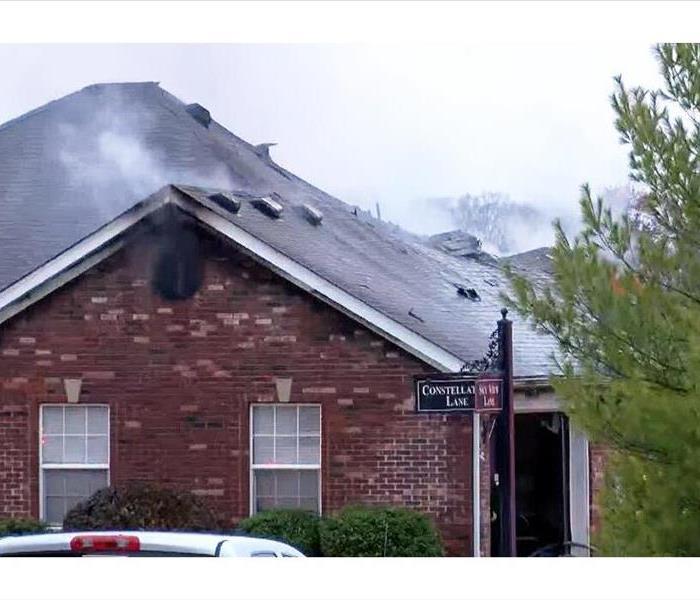 Storm Damaged Home
Storm Damaged Home
3 Differences between Flood Damage and Storm Damage
If your Champaign-Urbana building is damaged during a storm, you might think that all of the water damage falls into one category, but this is not necessarily the case. Flood damage is actually a bit different from other types of damage caused by water. The following are a few distinctions.
- Where the Water Comes From
Perhaps the easiest way to determine whether you are dealing with flood damage or other water damage is to figure out where the water is coming from. Generally, if the water comes from above, then it is regular water damage. This can include leaks and broken pipes. If the water is rising up from the ground, then this is always considered flood water.
- The Level of Water Contamination
A lot of the water involved in storm damage is considered to be category 1 or clean water. Water from damaged pipes or supply lines also belongs to this category. Flood water, on the other hand, is category 3 or black water. This means that it is highly contaminated and should be avoided. This is because water from a flood mixes with sewage and other contaminants on the ground. Anything that it touches, including home contents, will need to be thrown away or thoroughly sanitized.
- Whether It is Included in Your Insurance Policy
Another important difference between damage from a flood and damage from other water sources is that flooding is usually not included in your basic insurance policy. If you want coverage for this type of damage, then you will need to purchase a separate flood policy. Whether you are dealing with clean water or flood damage, you will need to have it taken care for quickly to avoid further damage to your building. Moisture of any type can contribute to weakened materials or mold growth. SERVPRO of Champaign-Urbana can remove the water and perform any necessary repairs.
Call us at 217-355-0077 at any time.
Winter storms cause frozen pipes
12/11/2019 (Permalink)
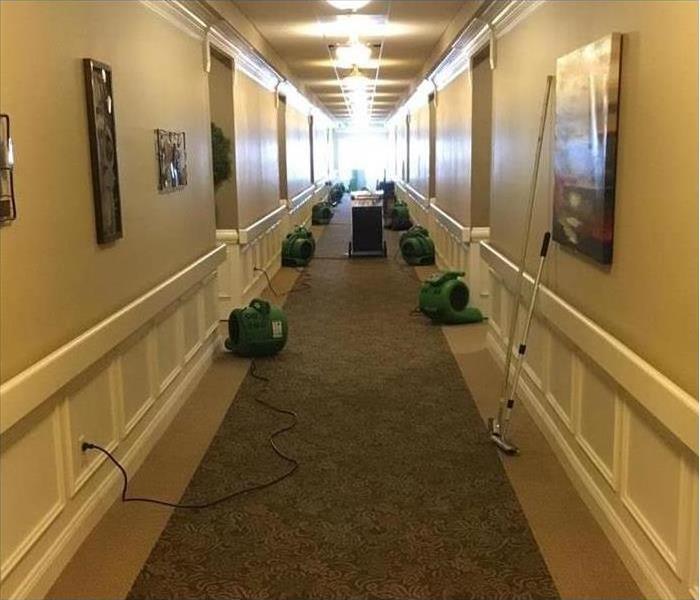 The assisted living hallway set up with SERVPRO air movers.
The assisted living hallway set up with SERVPRO air movers.
With certain areas of Central Illinois reaching lows of -15, old man winter let us have it. Extended periods of sub-zero temperatures bring on the dreaded frozen pipes, frozen pipes, of course, lead to broken pipes, which in turn lead to water damage. Depending on how long the water is allowed to run through your house, this could cause some serious damage.
We have learned to adapt to the cold weather temperatures in most cases. Unfortunately for an assisted living facility, the main water line for the sprinkler system, located on an exterior wall froze and broke. Within a matter of 48 hours, SERVPRO was able to have the residents back into their respective rooms.
Don't let a winter disaster, like this one, affect your comfortability this winter. Call your emergency service professionals at SERVPRO of Champaign/Urbana, (217)355-0077.
Keeping your home safe during the winter months
12/2/2019 (Permalink)
Whether you’re a recent homebuyer, new to the Mid-Western winter months, or just want to cover your bases heading into the holiday season: It’s important that you make sure your property is well taken care of. Putting together a thorough checklist ensures your home will be well-prepared for the inevitable sub-zero temperatures. This short read will put your mind at ease, protect your home, and hopefully keep your money where it needs to be…in your wallet!
- Making sure your doors, windows, and any other outside passage for air are correctly sealed ensures your furnace doesn’t work overtime heating the air coming from outside. When it comes to your electricity bill, sharing is NOT caring!
- Add extensions to all of your downspouts. This will prevent water from pooling around your foundation. Water will expand when frozen, and this will lead to damaging your foundation and further expense.
- Drain water out of sprinklers, hoses, faucets, and an exterior water source. Like we already mentioned, the frozen water will expand and will cause major damage.
- If you will be using your fireplace, make sure you have a chimney sweep inspect your chimney. Also, make sure to dispose of any fire hazards that could turn your small fireplace into a big bonfire! Make sure your fire extinguishers are up to date and inspect them to make sure they are functioning properly.
- Make sure your insulation is well maintained and any possible leaking of air is plugged. Keep your warm air in and the cold air out!
- Because heat rises, reverse your ceiling fans. This will push the warm air in your house down instead of pulling it up.
Following these tips to ensure a safe home during the upcoming winter months will have you enjoying your holiday season as you should be. Give your home the best present it could ever ask for, protection.
For any disaster service needs, trust in SERVPRO of Champaign/Urbana to take care of you. Reach out to us anytime day or night at (217)355-0077. Here to help make your disaster "Like it never even happened."
Happy Holidays from your friends at SERVPRO.
Deal With Storm Damage in Your Residence Through Prompt Restoration
10/21/2019 (Permalink)
Storm damage in your Champaign-Urbana home is no joke, we will help you!
Storms bring about the worst weather conditions, including strong winds, heavy downpour, and the sounds and sights of thunder and lightning. Strong winds can bring items like branches and debris crashing into your home, which can lead to structural damage like busted doors, broken windows, and cracked walls. Rainwater can also enter your living spaces, causing indoor flooding.
Once the storm is over, your home can be soggy and damaged, and your possessions could be heavily saturated. You, therefore, need to deal with the flood damage to make it inhabitable again. Prompt restoration can prevent the long term effects of flooding, such as:
Mold growth -
Mold spores can grow into colonies quickly after they are exposed to water. They can grow in damp materials after 24 to 48 hours. Mold can cause health issues to the occupants of a home and a strong, musty scent.
Fungal decay in timber -
Wood is prone to attacks from fungi. Ventilation and drying to wooden structures helps prevent fungi outbreaks.
Damp staining -
Floodwater may transport minerals in solution while moving through a building. The minerals can then get deposited on the floor and wall finishes, remaining there after the water evaporates.
To restore your home after a flooding incident, you need the right equipment, protective gear, and know the appropriate way to clean up, dry and sanitize the property. Therefore, it is advisable to entrust the restoration work to SERVPRO of Champaign-Urbana. Once we arrive at your home, we can inspect the destruction we are dealing with and provide you with an estimate. After that, we can proceed with the restoration process.
We remove scattered debris immediately to make it easier to assess and work on your home further. If there is standing water in your home, we can drain it out using portable or truck-mounted pumps. At times, our technicians use disinfectants to sanitize contaminated water before pumping it out.
We are cautious when pumping out high levels of water from crawl spaces and basements because the highly saturated soil adjacent to walls and foundations could collapse as a result of hydrostatic pressure. We dispose of the extracted water in a sanitary sewer system or at appropriately licensed disposal facilities.
Our SERVPRO of Champaign-Urbana technicians also dry a home effectively using air movers and dehumidifiers. After the restoration process, we perform a final inspection to ensure that you are happy with the result. Through the final inspection, we can know if we have missed anything important and confirm that your property is safe and secure. When you need flood damage restoration services contact SERVPRO of Champaign-Urbana at (217) 355-0077 for help. We have the expertise to make the damage seem, “Like it never even happened.”
(SB)
Lightning Strike surges power, causes fire
9/5/2019 (Permalink)
This picture shows the view of a basement stairwell. The fire impacted three levels of the home. A lightning strike to a tree in their backyard created a surge to the direct power line going into the home.
With three floors affected by the fire, there was a significant amount of water in the basement. The water that the fight fighters use to save your home and most of the belongings ends up saturating most of your home, especially the impacted area. This leads to other problems that can arise like mold, structural damage, and other foundation problems. When the drywall in your house becomes saturated and no drying process is started, and this goes for everything in the house, you can compound your problem to find secondary grown beginning to grow. This can take days, to weeks, to months depending on the conditions.
SERVPRO's number one goal is to put the victims of such a tragedy back into their homes as quickly as possible, and this homeowner called the right people to get the job done. From our fully staffed construction team to our staple in water mitigation, SERVPRO is capable of handling ANY size loss.
SERVPRO of Champaign/Urbana
(217)355-0077
24-Hour Emergency Services
Fire & Water - Cleanup & Restoration
Independently Owned and Operated
4 Steps Toward Safeguarding Businesses From Storm Damage.
5/3/2019 (Permalink)
4 Steps Toward Safeguarding Businesses from Storm Damage
Even businesses with strong disaster plans are affected by major storms, flooding, or fires. Forty percent of all businesses affected by disasters won't open their doors again. Within one year after the mess has been cleaned up, another 25 percent will fail. This is bad news for just about everyone involved. Fortunately, insurance providers, business owners, and community leaders can take preventative steps before disaster recovery is necessary.
1. Establish Written Business Continuity Plan
These documents should contain the procedures to take when disasters threaten, during disasters, and during the recovery period. For example, if storm damage is severe, business owners may need to relocate the workplace temporarily. Other elements of this plan may include phone trees, information technology procedures, and emergency evacuation responsibilities.
2. Schedule Regular Employee Trainings
It isn't enough to cover these storm response procedures in one workshop. Employees need to be familiar and comfortable enough with the steps that they remember and carry them out with ease. When employees are clear about their individual responsibilities and have performed them several times in non-emergency situations, they are more likely to respond calmly during a disaster.
3. Keep Emergency Supplies Handy
The right equipment and supplies are vital to the success of a disaster recovery plan. Business owners should have first-aid kits, flashlights, and other emergency supplies within easy reach for employees. Other equipment, such as clean water, food, a generator, and even blankets could further safeguard the well-being of company personnel.
4. Store Copies of Key Information in Multiple Sites
During a storm, it may be impossible to access phone numbers through workplace computers. After a flood, in-house copies of insurance policies may have been thoroughly damaged; a hard copy kept in another location could provide needed information. Contact information for cleanup and recovery professionals should be included.
Successful disaster recovery actually begins long before storms hit Champaign/Urbana. Communities, business leaders, and insurance professionals can do their part in protecting residents by providing documents and resources that increase participation in business continuity plans. SERVPRO of Champaign/Urbana will be glad to help you establish an emergency plan as well! Call (217) 355-0077 if you would like to set up an appointment.
(SB)
Are You Prepared for a Thunderstom?
4/2/2019 (Permalink)
During this time of year in Champaign-Urbana we can experience a lot of rain which can lead to thunderstorms. It’s important to be prepared and have a plan in place. Talk with your family and create an emergency plan for thunderstorms, floods, and tornadoes. Think about an emergency shelter and evacuation plan. Below we have a few suggestions to make sure you and your family are ready for whatever happens.
Protect your electronics
Your electronics can get fried if they are not properly protected. Plug electronics into a surge protector to avoid damage during a storm.
Prepare for power outages
Have battery-operated flashlights and lanterns in easy to get to places. Check on these items from time to time to make sure the batteries still work, replace them if necessary. Also, think about keeping the refrigerator and freezer doors shut to keep food from spoiling. If these food items rise above 40 degrees for 2 hours or more, they should be disregarded. Call your local power company to inform them of the outage and to get information regarding when the power should be restored.
Stay away from power lines
Do not go near power lines should they fall to the ground, they can be very hazardous. Call 911 if you see downed power lines.
Go inside when you hear thunder
If you hear thunder, it is likely that lightning is also occurring. Lightning can be dangerous, therefore, make sure to go inside when thunder occurs.
Seek shelter
There are many different natural elements which can occur and be harmful when outside during a disaster. Therefore, during a storm, it is important to seek shelter and be safe. If your inside, a good place to be is at the lowest level of your home. If you have a basement or storm cellar you can hang out in until the storm passes.
Keep an emergency kit ready
Consider putting together a kit of things you may want to have on hand during a storm. Items you may want to include would be water, non-perishable food, flashlights, blankets extra batteries, a radio, and a first aid kit. If you have an emergency does strike your home during a thunderstorm, SERVPRO of Champaign-Urbana is ready to help get your life back to normal.
Call us in Champaign-Urbana, at (217)-355-0077 any time day or night, We are always ready to help. [JB]
Your Family Home and Flood Damage in Champaign-Urbana
3/11/2019 (Permalink)
Thorough Flood Damage Cleanup
Most of the time, heavy rain showers and thunderstorms bring pleasant feelings. There are times, though, when flooding is a direct result of these as they pass through the Champaign-Urbana area. Rainfall must have somewhere to go, or downhill areas suffer greatly.
There is always new construction in Champaign-Urbana, and this sometimes leads to flood damage of nearby homes. When the terrain in a section of town changes, it can cause rainfall to collect in areas that cannot adequately handle the amount it receives. The water must go someplace, and as a result, it spreads out and enters homes.
Cleaning up after a flood is a very messy task. Working together as a team, SERVPRO of Champaign/Urbana employees restore homes affected by flooding disasters. After removing the majority of the soil brought into your home by the water, slowly but steadily drying out your home is our next goal. As this happens, we remove damaged and non-salvageable items so we can concentrate better on cleaning and sanitizing the rest of your home and its contents.
It is important we thoroughly clean so that everything is sanitary and safe. Microbes can live in barely moist environments, so ensuring that your home is completely dry is also a crucial part of the restoration process. Our cleaning procedures can also include the use of antimicrobial agents to prevent secondary growth. If any of these microorganisms are present, removal of most during the cleaning process happens readily. This is more beneficial than waiting for larger problems to develop and then taking care of them later.
Your kitchen is where you prepare your family's meals and snacks, and having a low level of contaminants and pathogens is vital for keeping your family healthy. We can sanitize every surface in your kitchen to help ensure that no flood-borne diseases can make your family ill. We can also inventory your food items that must be disposed of for you to give to your insurance provider if you choose to file a claim.
Whenever you need us to make it “Like it never even happened.” call SERVPRO of Champaign/Urbana at (217) 355-0077, regardless of the time of day, 365 days a year. We always answer our phone, so you can speak to someone who can help you right away.
(SB)
Are You Ready For Severe Weather?
2/15/2019 (Permalink)
Severe weather is unpredictable and SERVPRO of Champaign/Urbana wants you to be safe no matter the season! Below are some severe weather readiness tips to help guide you, no matter what type of disaster you may encounter.
Weather Radios: Weather radios are the most reliable way to receive notifications of severe weather in your area. Although cellular phones, weather apps, social media as well as wireless emergency alerts (WEA’s) are what the majority of us depend on to keep informed, the truth is those devices can have their limitation during severe weather and can be interrupted. Mobile devices rely on towers and those towers can be damaged and cease to function during sever weather. A weather radio, WITH CHARGED BATTERIES is the most reliable way to be informed of severe weather. Be sure to properly program your weather radio so you only receive the alerts you want for the counties you want.
Emergency Supply Kit: Having an emergency kit can be a life saver. Most emergency management agencies recommend supplies for up to three days. The following is a list you can use as a guideline:
- Water (1 gallon per person per day)
- Food (non-perishable)
- Manual can opener
- Battery operated radio, preferably a weather radio
- Flashlight
- Extra batteries for radio and flashlight
- First Aid kit
- Whistle to signal help
- Clothing, blankets
- Dust mask or bandannas
- Plastic sheeting, garbage bags, and duct tape
- Wrench or other tools to shit off utilities
- Hygiene items
- Important documents. (Copy of insurance policy, bank account info, identification, etc.)
- Fire extinguisher
- Matches in waterproof case
- Cash
Make family plan: Make sure all members in the household are aware where they are to go in the event of severe weather. If for some reason the family is separated in the event of a severe storm, have a meeting place established as to aid in finding each other amidst devastation.
Overflowing Storm Drains Can Cause Flood Damage To Homes.
1/31/2019 (Permalink)
SERVPRO of Champaign/Urbana Can Remediate Flooding After Storms or Snow Melts
Rainfall and melted snow provide our lawns with the water they need to grow well, but not all of the water that falls on your property ends up soaking into the ground of your Champaign/Urbana property. Much of it runs off into the street where it travels down to the drainage system.
When a neighborhood contains many trees or other debris sources, homes in the area can become flood damaged. When these drains become clogged, they force the water to either continue down the street or to overflow into yards and parking lots. This can happen in any neighborhood.
We at SERVPRO of Champaign/Urbana make sure that each one of our customers receives the level of service their own unique needs require. We understand that floods do more than just damage the interior of the home. Flooding also affects the exterior of the home, as well as the yard. No matter where flooding damages your property, or how severe that damage becomes, we handle all aspects of restoration and quickly make it “Like it never even happened.”
SERVPRO of Champaign/Urbana is always ready to help local families recover from flood damage and other catastrophes that affect their residences. Call us at (217) 355-0077 anytime so we can help your family move forward after a flooding event.
Seasonal Storms Hitting Illinois
1/17/2019 (Permalink)
SERVPRO is Ready to Help with ANY Kind of Storm Damage
Illinois has a widely diverse and often unforgiving climate, making it on the receiving end of damage from a wide range of dangerous storms and natural disasters. Tornadoes can cause huge damages to entire towns, massive hailstones have been known to destroy cars and smash through roofing, and storms in both the summer and winter have the potential for serious flooding and water damage. Storm damage here varies widely in appearance and specifics, but SERVPRO of Champaign/Urbana is prepared year-round for all types of natural disasters common in the season.
Tornadoes
Call them tornadoes, twisters, or whatever you like, but these violent natural disasters cause some of the most severe storm damage we see in Illinois. Tornadoes can completely demolish a home, sometimes making rebuilding and replacing the only sustainable option for unfortunate homeowners. However, more commonly, a home may be affected to a mild or moderate degree and only require matching restorations to specific areas of concern. If you are unsure of how long or how much money a tornado restoration could take, be sure to call us for a quote.
Snow and Ice Storms
Snow can still cause significant damage in the coldest months of the year. Snow can seep into foundations, pile up and freeze in the yard, or cause ice dams that directly lead to water damage problems. When regular shoveling fails, SERVPRO of Champaign/Urbana is ready to help with any damages taken by your home.
Heavy Rain Storms
In some cases, ordinary rainstorms can be heavy enough to cause flooding or other severe damage to local homes, especially in the late spring and summer. A storm may even, bring a massive amount of moisture and destruction. In the event of flooding, make sure your valuables are secured and elevated and try to stay in a safe place or on the upper floors of your home. SERVPRO of Champaign/Urbana has helped hundreds in the local area to recover from water, storm, fire, and other types of damage to their homes. For our assistance, just call us 24/7 at (217) 355-0077.





 24/7 Emergency Service
24/7 Emergency Service

